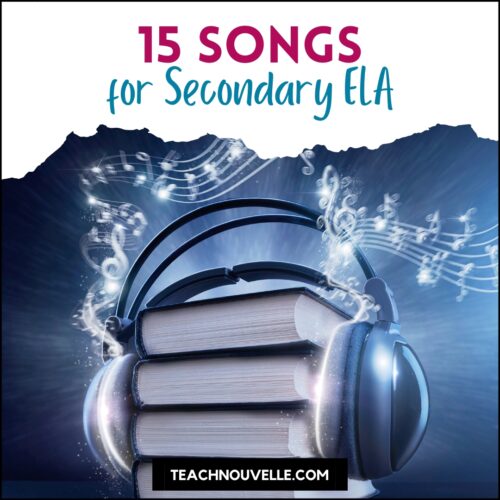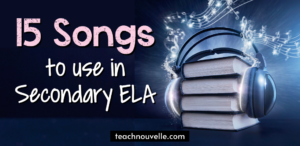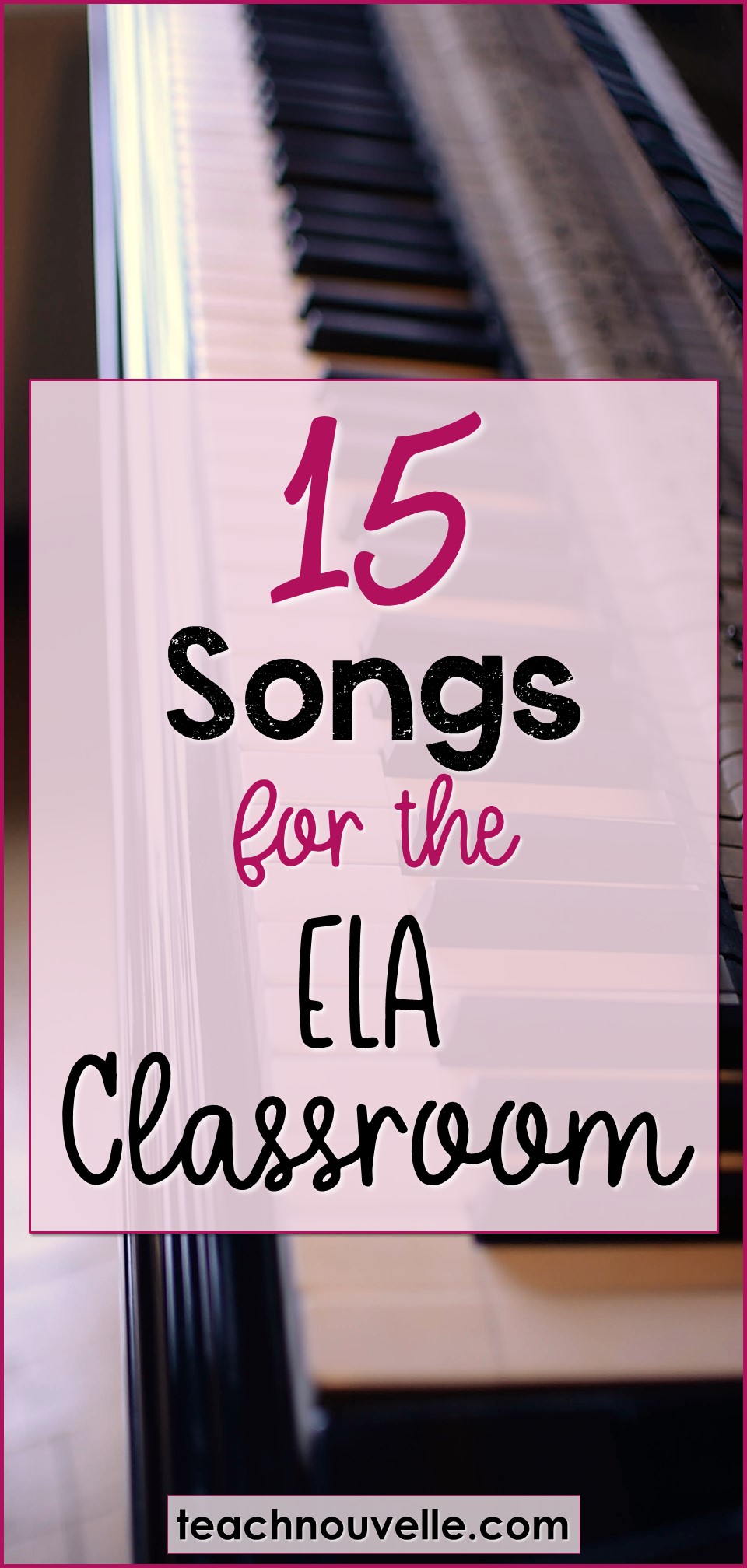Want to expose students to new songs, or make them think about old songs in a completely new way? Using music in the classroom is a great way to engage students, so here are some songs to use in ELA, and some ways to use them.
I’m going to link to the YouTube videos of these songs for your convenience, but please know that I do not always show music videos in my class. Most of the time, students just listen to the music. Music videos can be distracting, and sometimes inappropriate. Does it go without saying to always preview songs & their videos for content before sharing them? (Just covering myself here, folks!)
Also, if you are looking for ways to lessons to help students analyze short texts, like songs, short films, and more, our 15 Pop Culture Analysis Activities resource has got you covered!
Update: Thanks everyone for all the comments and shares! Since this subject resonated so much with y’all I made a sequel post, 15 More Songs to Use in ELA, check it out after you read this one 🙂
Songs to Use in ELA
1. “The House That Built Me” by Miranda Lambert
“I thought if I could touch this place or feel it
This brokenness inside me might start healing.”
With imagery like “handprints on the front steps”, the lyrics to this song evoke a strong feeling of nostalgia. In literature, ‘home’ is often more than a physical place, it’s a metaphor. Students could explore that idea by reading the lyrics to this song along with some classic poetry such as, “The Self-Unseeing” by Thomas Hardy, “Home is so Sad” by Philip Larkin, or “The Props assist the House” by Emily Dickinson. This is great practice of CCSS.RL.9-10.7, comparing the development of a theme in two mediums.
Looking for ways to support your students as they analyze lyrics? Look no further, my friend.
2. “Cat’s Cradle” (Harry Chapin)
“And the cat’s in the cradle and the silver spoon
Little boy blue and the man in the moon
When you coming home, dad?
I don’t know when,
But we’ll get together then.
You know we’ll have a good time then.”
I introduce this song in our Short Stories Unit also, and students analyze it for literary devices. It’s a great song to look at for mood, allusion, and irony. You can also pause this song midway and ask students what their expectations are for the ending – this song is upbeat and jovial at the start, so student expectations are often subverted.
Need something else? You can find ALL my recommendation lists for inclusive classroom materials here. Poems, novels, TED talks, short stories, and so much more!
3. “Buffalo Soldier” by Bob Marley
One reason I love this song is that Marley purposefully reminds the listener of how these men came to be soldiers:
“Stolen from Africa,
brought to America.
Fighting on arrival,
fighting for survival”.
This song would pair well with a nonfiction article about the Buffalo Soldiers. Many historians are quick to praise the Buffalo Soldiers for their bravery and their accomplishments, but it’s vital to understand the context of their enlistment. According to this article from Smithsonian Mag, “African Americans could only serve west of the Mississippi River, because many whites didn’t want to see armed Black soldiers in or near their communities.” Furthermore, they “often faced extreme racial prejudice from the Army establishment”.
4. “The Lighthouse’s Tale” (Nickel Creek)
“I am a lighthouse, worn by the weather and the waves.
I keep my lamp lit, to warn the sailors on their way.
I’ll tell a story, paint you a picture from my past.
I was so happy, but joy in this life seldom lasts.”
This is another song my students tackle during the song analysis lesson in our Short Stories Unit. This sad song is sung from the perspective of a lighthouse, and you can pretty much tell from these first few lines that it’s going to be a downer. This is a great song to analyze for perspective, foreshadowing, conflict, and mood.
5. “Pray for Me” by The Weeknd feat. Kendrick Lamar
“Tell me, who’s gon’ save me from myself,
when this life is all I know?
Tell me who’s gon’ save me from this hell?
Without you, I’m all alone.”
This song presents a conflicted hero: someone who worries about losing himself in his responsibilities. And yet, the protagonist finds the power within himself (and his community) to rise up. This song accompanies the powerful trailer for Marvel’s Black Panther, and so you could do a combined song and video analysis. I love discussing superheroes as literature, and this song is the perfect inner monologue of a hero. Students can dig deep in examining his motivations and hesitations.
Read about more ways to use pop culture in ELA!
6. “Handlebars” (Flobots)
“Look at me, look at me
Hands in the air like it’s good to be
Alive!
And I’m a famous rapper
Even when the paths are all crookedy
I can show you how to do-si-do
I can show you how to scratch a record
I can take apart the remote control
And I can almost put it back together”
Okay, so this is one of my all-time favorite songs and if you haven’t heard it, you should go listen to it right now. In all honesty, I discovered this song set to a fan video about the 10th Doctor (David Tennant) in Doctor Who, and it has stuck with me ever since. This song follows two friends full of bravado and derring-do (they ride their bikes with no handlebars, after all), and then the song takes a major turn and becomes quite epic. (The original Flobots video is a must-watch) Great song to discuss conflict, foreshadowing, and tone.
7. “My Shot” from Hamilton by Lin Manuel-Miranda
“Hey yo, I’m just like my country:
I’m young, scrappy and hungry
And I’m not throwing away my shot.”
If you’re not already using Hamilton in your classroom, what are you waiting for?! Lin Manuel-Miranda’s ‘revolutionary’ (get it?) approach to the founding fathers can spark a lot of genuine interest and excitement in students. Use this song to illustrate so many poetic devices: rhyme, meter, rhythm, simile, metaphor, repetition, etc. Students could match the lyric snippet with the device. Or students could do a ‘scavenger hunt’ for the poetic devices. If you’d like to do a more focused study of a device, you could talk about the dramatic irony in this song – we the listener know that Hamilton dies in a famous duel by “throwing away his shot”.
Caution: This song has a few instances of potentially objectionable language.
8. “I’ll Make a Man Out of You” (from Mulan)
“Let’s get down to business, to defeat the Huns
Did they send me daughters, when I asked for sons?
You’re the saddest bunch I ever met
But you can bet before we’re through
Mister, I’ll make a man out of you.”
This is one of my favorite songs to use in ELA. Mulan is my favorite Disney movie, so of course I bust out this song when we get to our irony lesson. This song is a great example of dramatic irony, since the audience knows that Mulan is a woman, and Li-Shang doesn’t. But this song could get more mileage if you were so inclined — there’s a strong message about determination and bravery, even in the face of doubters (Sorry, Li-Shang, but you’re a doubter, bud.).
9. “Times They Are a Changin’” by Bob Dylan
Written over fifty years ago, this song remains one of the most powerful anthems to come out of the folk revival of the 1960s. It encapsulates the zeitgeist of that era, but it’s resonating with listeners today. when many Young people like the then 22-year-old Dylan felt misunderstood by their parents generation:
“Come mothers and fathers throughout the land
And don’t criticize what you can’t understand.
Your sons and your daughters are beyond your command.
Your old road is rapidly agin’.”
And unheard/unserved by their elected officials, more interested in protecting the status quo than enacting change:
“Come senators, congressmen,
Please heed the call:
Don’t stand in the doorway;
Don’t block up the hall.”
Dylan wrote this song to inspire action. It’s important for our students (future voters!) to feel like they can affect change. What issues are your students passionate about? Have them write a letter to the elected official of their choice. Provide a list at the local or national level and let students choose 🙂
10. “The Girl in a Country Song” (Maddie & Tae)
“Bein’ the girl in a country song
How in the world did it go so wrong?
Like all we’re good for
Is looking good for you and your friends on the weekend
Nothing more”
This song is an amazing lampshade of country music’s inclination to two-dimensionalize women. It’s also funny and full of heart, and a great way to introduce tropes to your students. This would be a great intro to students discussing tropes they see in other genres, and could even lead to a larger analysis of when genre standards become trope-y.
Find resources for student-created songs in ELA.
11. “The Star-Spangled Banner” by Jimi Hendrix
Jimi Hendrix’s iconic 1969 performance of The Star-Spangled Banner at the Woodstock Music Festival has been the subject of many critical evaluations, and, at the time, a lot of hate mail! Woodstock was a culmination of counterculture and anti-war movements of the 60s, and its performers and attendees were judged harshly by many in the mainstream. Many viewed Hendrix’s performance as anti-American or an insult to the military. It should be noted that Hendrix enlisted in the Army in 1961 and trained as a paratrooper in the 101st Airborne Division. Shortly after Woodstock, Hendrix appeared on the Dick Cavett Show and was asked about the meaning behind his performance. He said, “I’m an American, so I played it… I thought it was beautiful.”
Playing the video of his performance would be a unique opportunity for students to analyze the tone, meaning, and purpose of his performance. It could also be a chance for students to learn about the racist origins of The Star-Spangled Banner.
12. “Go to Sleep You Little Baby” (O Brother, Where Art Thou?)
“Go to sleep you little baby
Go to sleep you little baby
Come lay your bones on the alabaster stone
and be my ever loving baby.”
You don’t have to teach The Odyssey to work this song into your ELA classroom. Although this is O Brother, Where Art Thou’s version of the Siren Song, your students can still appreciate how haunting it is without connecting it to the original text. This song was based on a traditional lullaby, but really subverts our expectations and becomes sinister by the end. This is a great song to use to discuss tone and suspense.
13. “Conversations with My 13-Year-Old Self” by P!ink
“Come over here and let me hold your hand and hug you darling.
I promise you that it won’t always feel this bad.
There are so many things I want to say to you.
You’re the girl I used to be,
You little heartbroken thirteen-year-old me.”
In this heartfelt ballad, P!nk offers some wisdom and encouragement to her past self. Although your students aren’t *much* older than 13, they can still reflect on their lives. Use this song to introduce an activity where your students could write a letter to their past self, at any age. Self-reflection, and self-empathy are important parts of maturing and learning to make better choices. Plus, exercises like this can help students build executive functioning skills.
If you’re teaching Romeo & Juliet, this might be beneficial for young folks with big emotions. Here are other song pairings for Romeo & Juliet!
14. “After We Shot the Grizzly” (The Handsome Family)
“After we shot the grizzly
After the airship crashed
After we lost the compass
After the radio went dead…”
Okay, so I’m probably a little weird for adding this to the list, but it’s a deeply macabre song that’s also really hilarious. I haven’t tried this in my classroom yet, but I fully believe that my students will appreciate this gallows humor. That’s really all I have to say about this – use it with a horror unit (like Edgar Allan Poe) or use it to discuss how comedy can be derived from terrible circumstances, and how masters of the craft accomplish that. You can also talk about tone and suspense, since it’s so jovial, but so dark.
Theme in Songs Portfolio: use songs to study theme.
15. “We Become Silhouettes” (The Postal Service)
“I’ve got a cupboard with cans of food, filtered water,
And pictures of you and I’m not coming out
Until this is all over.”
This is a surprisingly jaunty fallout shelter song. The vibe is strong dystopian and you can easily talk about setting and conflict, but a metaphor crystallizes as the song continues and it’s possible to read this as a breakup song.
What Next?
Check out these songs, and let me know what you think!
I also wrote about using music in the ELA classroom on The Secondary English Coffee Shop, so be sure to follow that blog for more ideas 🙂
What are your favorite songs to use in ELA? I’d love to hear from you in comments. 🙂 And if you liked this post, don’t forget to check out the sequel, 15 MORE Songs to Use in ELA.







14 Comments
Amy
September 3, 2017 at 9:56 amThanks so much for this. Totally adding Ursula to my persuasion unit!
Jody Andriano
September 10, 2017 at 6:59 pmMy very favorite is “Walk Tall” by John Mellencamp. I use it to teach satire along with the novel Huck Finn.
Danielle Hall
September 11, 2017 at 9:00 amAmazing idea, Jody! Thanks so much for sharing!
15 TV Episodes to Use in ELA - Nouvelle ELA Teaching Resources
September 12, 2017 at 6:02 pm[…] Do you love lists? Check out 15 Songs to Use in ELA! […]
Glenna
September 13, 2017 at 8:42 pmThese are excellent. I teach high school English and am excited about sharing and using these!!
Tara Brown
September 30, 2018 at 12:29 pmI love using Love Story! Great list -thank you so much! 🙂
Teaching Photo Analysis to Build Text Connections - Nouvelle ELA Teaching Resources
October 29, 2018 at 1:55 pm[…] advocate for integrating even more types of text into your curriculum! While we’re here, here are 15 Songs and 15 TV Episodes to Use in […]
Teaching Short Stories: Innovate & Engage - Nouvelle ELA Teaching Resources
November 16, 2018 at 4:12 pm[…] During my Short Stories Unit, I also mix in some short films and songs to use as mentor texts. Check out my list of favorite songs for ELA here. […]
Gwen
September 5, 2019 at 4:02 amI LOVE using “I’ll Make a Man Out of You” from Mulan to reinforce Figurative Language as well. It’s full of hyperbole, metpahors, similes, idioms, and personification.
15 MORE Songs for the ELA Classroom - TeachNouvelle.com
September 5, 2019 at 8:01 am[…] and you shall receive! My other post, 15 Songs to Use in ELA has gotten so much positive feedback that I decided to make a sequel 🙂 Like before I am linking […]
Penelope Mann
September 19, 2019 at 8:40 pmThank you! It is my first year teaching 9th grade English. We are in our short story unit and I thought it would be fun to break it up by analyzing songs. Thank you for the suggestions!
10 Halloween Activities for Secondary ELA - Nouvelle ELA Teaching Resources
October 3, 2019 at 8:47 am[…] etc.) or have students connect it to other texts they’ve read or watched. Check out these other songs to use in ELA, year […]
Jenni Weston
June 2, 2020 at 12:10 amI love to use “Angel in my House “ by The Story (Jonatha Brooke). This song enhances Virginia Woolf’s idea of every woman’s struggle to “kill the angel” that suppresses their free will and wild heart.
“My mother moved the furniture, when she no longer moved the man…”
Dream of me Man2sky
September 17, 2023 at 8:58 amI always used to read article in news papers but now as
I am a user of net therefore from now I am using net for posts, thanks
to web.